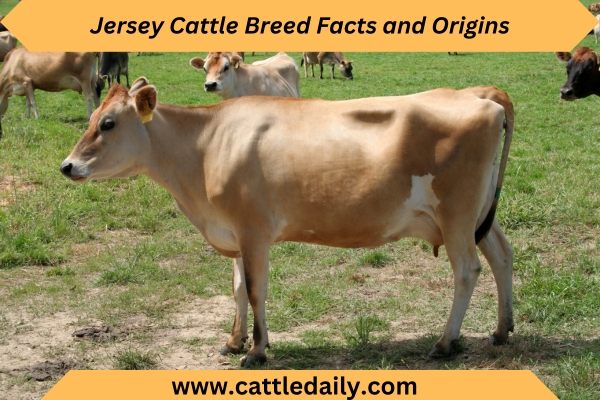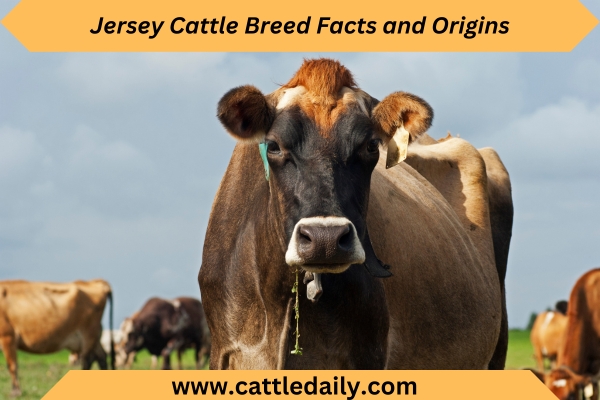Jersey Cattle Breed Facts and Origins
Known for their rich, creamy milk and friendly personalities, Jersey cattle hold an important place in the worldwide dairy industry today. Originating from Jersey Island in the English Channel, these small brown cows have won favor among dairy farmers and homesteaders alike.
If you’re considering adding Jersey cattle to your farm, then you are at the right place. In this article, we will explore and learn more about this popular breed’s origins, physical traits, and common uses in modern agriculture.
Breed History and Origins
Jerseys trace their origins to the Isle of Jersey, a small British island located in the English Channel off the coast of Normandy, France. The breed was developed on the island’s rugged terrain and limited pastureland, resulting in a smaller cow well-suited for grazing hilly coastal areas.
The exact origins of the Jersey are unknown, but it likely descended from cattle brought to the island by Norse settlers in the 9th and 10th centuries.
Over several centuries, these cattle developed into a distinct breed adapted to the island’s environment. By 1771, Jerseys had achieved official recognition as a breed.
In the 19th century, Jerseys began being exported to England and the United States. The breed’s buttery milk soon made it a favorite among dairy farmers in North America and Australia. Today, the Jersey is the second most popular dairy breed in the U.S., behind only Holsteins.
Why are Jersey Cattle Important?
Jersey cattle hold an important place in the dairy industry worldwide. As the second most popular dairy breed in the U.S. and a top breed globally, Jerseys make valuable contributions to milk production.
Jerseys produce milk with the highest butterfat and protein content of all dairy breeds. At around 4.9-5.5% butterfat, Jersey milk is ideal for products like ice cream, butter, and cheese. This gives it added value over standard milk.
The breed also exhibits feed efficiency – Jerseys convert feed into milk components rather than excess body fat. Their small size allows them to thrive on limited pasture. For homesteaders, Jerseys are an excellent family cow choice.
Finally, Jerseys possess traits like fertility, udder health, and longevity that make them profitable and sustainable for dairy producers. For all these reasons, Jerseys continue to play a key role in the dairy cattle industry.

Physical Characteristics
Size
Jersey cows weigh around 900-1200 pounds on average. They are quite small compared to Holsteins, which can weigh over 1500 pounds. Due to their petite size, Jerseys eat less and require less pasture space than larger dairy breeds.
Color
Jerseys come in various shades of brown, from extremely light tan to almost black. They frequently have a darker line along their back and across their shoulders. Other distinguishing features are a black hide with a tan or white muzzle.
Other Physical Traits
In addition to their small stature and brown coloring, Jerseys have large expressive eyes and a straight profile. Their black tongues are another distinctive trait. Jerseys possess an athletic yet graceful build with lean, angular features. Udders are visible high behind the front legs.
Jersey Cattle Today
Where are Jersey Cattle Found Today?
While originating on Jersey Island, Jerseys now thrive in temperate climates worldwide. Some of the top countries for Jerseys today include the U.S., Canada, England, South Africa, Australia, and New Zealand. They also do well in tropical regions like Brazil thanks to heat tolerance.
What are They Used For?
Jerseys are principally a dairy breed, raised for their high-quality milk. However, they also produce fine-textured lean beef. Jerseys steers are commonly used for crossbreeding in beef operations. Some niche meat farmers also market Jersey beef as having health benefits from nutrients like CLA.
Benefits of Raising Jersey Cattle
For dairy farmers, Jerseys offer high milk components to earn premium milk prices. Their feed efficiency is another plus. Homesteaders appreciate Jerseys for their amenable temperament and moderate size.
Jerseys are excellent grazers, doing well on pasture. They also exhibit favorable fertility, calving ease, and longevity traits. In general, Jerseys are healthy, robust, and long-lived cows, whether used for small or large-scale dairy production.

Fun Facts About Jersey Cattle
- Jersey cows are quite small, weighing around 900-1200 pounds on average. Due to their petite size, Jerseys produce less milk than larger dairy breeds but with higher concentrations of milk solids.
- Jerseys come in all shades of brown, from extremely light tan to almost black. They have a characteristic dark brown or black hide with a tan or white muzzle.
- The high-protein A2 beta-casein found in Jersey milk may be easier to digest for some people than A1 milk from Holstein cows. However, more research is still needed in this area.
- Thanks to their friendly and docile temperament, Jerseys make excellent family cows for small homesteads. They are known as gentle cows that interact well with children.
- While they originated on the island of Jersey, Jerseys now thrive in climates worldwide from the tropics to cold northern regions.
- Relative to their body size, Jersey cows eat less than other dairy breeds while still producing top-quality milk. This makes them an efficient, low-maintenance breed.
- Jersey milk has the highest butterfat and protein content of all popular dairy breeds, ranging from 4.9-5.5% butterfat. This rich milk is ideal for products like butter, cheese, and ice cream.
- Due to their high-component milk, Jerseys often earn premium prices for their milk compared to standard commodity milk prices.
- Jerseys are known as “carb watchers” in the bovine world as they efficiently convert feed into rich milk as opposed to excess body fat.
- While not the highest milk producers in terms of volume, Jerseys lead the dairy cattle world in efficient milk production for their body size and dietary needs.
Conclusion:
Jersey cattle offer numerous benefits that have made them a mainstay among dairy producers globally. From their high milk components to feed efficiency and docile temperament, Jerseys excel whether managed on small family farms or large commercial dairies.
Yet they still maintain the heritage traits that allowed them to thrive for centuries on the rugged island of Jersey. For any farmer seeking an productive and personable dairy cow, the Jersey merits strong consideration. Learn here more about cattle breeds types and guides.


